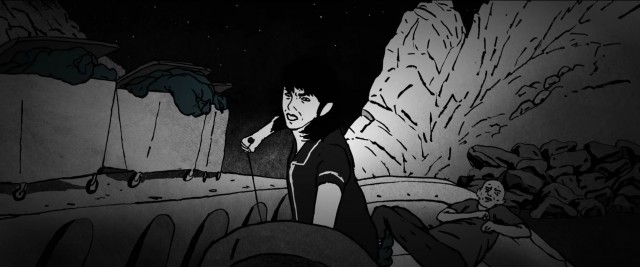Definitely one of those titles that sounds better in French, than it does in English, Gabriel Harel’s award-winning animation La Nuit des sacs plastiques (Night of the Plastic Bags) takes a bizarre premise and delivers a narrative of surprising depth. Set in a world being consumed by plastic bags, Harel’s 18-minute short uses stark B&W animation, with splashes of colour, to immerse its viewers in a film which is part ecological thriller, part George A. Romero tribute.
Opening at an illegal rave, where we follow Agathe as she looks to reunite with her DJ ex-boyfriend Marc-Antoine, the first indication we have that her night won’t pan out as expected comes when a plastic bag wraps itself (face-hugger style) round a bystander’s head. With this initial “attack” presented in a comedic fashion, it’s a slick and accessible entrance into Harel’s world, but as we enter the party, the storyline driven by the pulsating beats of the soundtrack, we realise those bags are no joke.

Agathe meets with her ex Marc-Antoine at a rave and the plastic bags start to attack.
Although the film obviously has a strong ecological message, inspiration came from an unexpected place – a telephone call the director had with his sister. “I wanted to make a fantasy/horror animation film with a monster”, Harel explains in this interview with Emilio Mayorga for Variety. “My sister was in Marseille, and during the phone conversation I was able to hear the Mistral wind through the phone and also a machine with a water jet cleaning the street. My sister talked to me about her worries — she had left her boyfriend after a 10-year relationship. Suddenly I heard a violent gust and she uttered a terrible scream. Then there was a lot of noise through the phone. After a while she told me that she had been attacked by a plastic bag straight in the face! A fucking plastic bag all wet from the disgusting gutter. I felt shocked, but I thought, okay, I have my monster!”
Though the killer plastic bags takes centre stage in Harel’s short, the sub-plot concerning Agathe’s desire for children makes for an interesting contrast, especially as her focus doesn’t alter, even when the world is crumbling around her. In a way, both storylines are concerned with time, the ecological thriller element amplifying the ticking clock regarding the global crisis caused by plastic pollution, while Agathe, at 39, obviously feels like she is engaged in her own battle against time. Both narrative threads have their own appeal as well, the genre-element of the story sure to draw fans of apocalyptic tales, while Agathe’s personal struggle adds complexity and depth, for those looking for a little more.

Over the course of the night Agathe will fight both mentally and physically for her ex-boyfriend
Featuring a truly unforgettable conclusion, there’s so much going on in Night of the Plastic Bags it’s many layers will prove a thought-provoking watching for audiences young and old. For me personally, it was the environmental message that reverberated longest, the genre-wrapping feeling like the perfect approach to get the message across. While I alway think it’s important for each individual viewer to take their own personal interpretation from a film, I love this breakdown of the narrative from its creator (once again from that Variety interview):
“The short is about the invasion of plastic and plastic waste. The plastic bag symbolizes plastic waste in its more extraordinary qualities – it is very light and resilient, it has a very long life expectancy and can swim, fly… So I started imagining plastic bags as a living animal species. And what fascinates me is that they imitate jellyfish (the first living beings on earth) and that they could also be the last living beings on earth. Then I also asked myself the question of their reproduction since this is the ultimate goal of any living species”.
Night of the Plastic Bags is Harel’s second short, after fellow festival favourite Yul et le Serpent (which is also available online, if you speak French) and was nominated for the Illy Prize at Cannes 2018 and won the César Award for Best Short Film – Animation in 2020.

 Rob Munday
Rob Munday